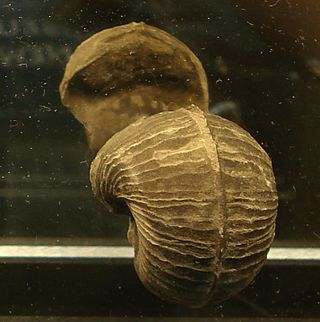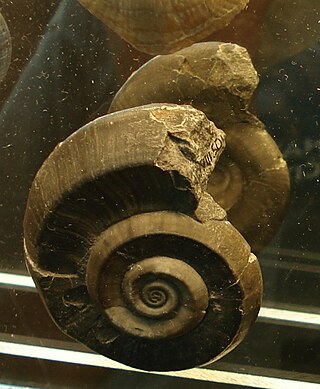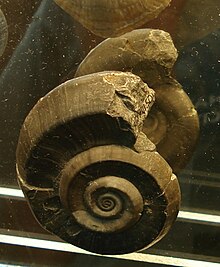
Caenogastropoda is a taxonomic subclass of molluscs in the class Gastropoda. It is a large diverse group which are mostly sea snails and other marine gastropod mollusks, but also includes some freshwater snails and some land snails. The subclass is the most diverse and ecologically successful of the gastropods.

Bellerophon is a genus of extinct paleozoic marine molluscs of uncertain position in the family Bellerophontidae.
Strepsodiscus is an extinct genus of very primitive fossil snail-like molluscs from the early part of the Late Cambrian of North America. The coiled, slightly asymmetrical shells are about 3 cm in height. It is not known whether these are shells of gastropods or monoplacophorans, which are more primitive mollusks.

The Bellerophontida is a taxonomic order of extinct marine mollusks that are found in the fossil record from the Lower Cambrian to the Lower Triassic. They are considered by some experts to be primitive sea snails with primarily symmetrically coiled shells, marine gastropod mollusks.

The Bellerophontidae are an extinct family of specialized globose bellerophontids, Paleozoic and early Triassic mollusks of the class Gastropoda.

The Euomphalina comprise a major suborder of mainly Paleozoic archaeogastropods, shells of which are hyperstophic to depressed orthstrophic, commonly with an angulation at the outer upper whorl surface thought to be coincident with the exhalent channel; shell wall thick, outer layer calcitic, inner layers aragonitic but not nacreous; operculum calcareous and heavy. Their range is from the Upper Cambrian to the Triassic, and possibly as high as the Upper Cretaceous.

Helcionelloida is an extinct group of ancient molluscs. These are the oldest known conchiferan molluscs, that is, they had a mineralised shell. Some members of this class were mistaken for Monoplacophorans. The class was erected by Peel in 1991.
The taxonomy of the Gastropoda, as revised by Winston Ponder and David R. Lindberg in 1997, is an older taxonomy of the class Gastropoda, the class of molluscs consisting of all snails and slugs. The full name of the work in which this taxonomy was published is Towards a phylogeny of gastropod molluscs: an analysis using morphological characters.

Bellerophontoidea, common name "bellerophonts", is a superfamily of extinct planospirally-coiled globose molluscs. This superfamily is generally included within the Gastropoda, but may instead be a group of monoplacophorans. The taxon first appeared late in the Cambrian and continued until late in the Triassic.

Euomphalidae is an extinct family of Paleozoic to early Mesozoic marine molluscs which may be gastropods with anisostrophically coiled shells . The shells show a selenizone.
Bucanellidae is an extinct family of Paleozoic molluscs of uncertain position, belonging either to Gastropoda (snails) or Monoplacophora. The family lived from the upper Cambrian to middle Permian and the shells are characterized by a relatively small median sinus in the upper margin of the aperture, and collabral (transverse) or spiral (longitudinal) threads covering the shell. The shells are planispirally coiled rather than trochospirally with a spire as is the case with most shelled gastropods.
Bucaniidae is an extinct family of Paleozoic molluscs of uncertain position possibly being either gastropods or monoplacophorans in the superfamily Bellerophontoidea. The family lived from the Lower Ordovician to the Devonian and have shells in which the apertural margins tend to flare. Most genera have a slit and selenizone, others some modification of this feature.
Euphemitidae is an extinct family of Paleozoic fossil molluscs of uncertain position. They have isostrophically coiled shells and may be either Gastropoda sea (snail)s, or Monoplacophora.

Macluritidae is an extinct family of relatively large, Lower Ordovician to Devonian, macluritacean gastropods(?), hypserstrophically coiled, that is dextral while appearing sinistral, of which the genus Maclurites is arch-typical. The base of their shells is flat or gently protruding while the upper side is generally concave.
Omphalotrochidae is an extinct taxonomic family of Paleozoic molluscs (gastropods?) with anisostrophically coiled shells of uncertain position (Gastropoda?).
Omphalocirridae is an extinct family of Paleozoic molluscs (gastropods?) with anisostrophically coiled shells of uncertain position (Gastropoda?).
Helicotomidae is an extinct family of Paleozoic molluscs (gastropods?) with anisostrophically coiled shells of uncertain position (Gastropoda?).
The Anomphalidae is an extinct family of fossil sea snails, marine gastropod mollusks. These are archaeogastropods which are included in the suborder Trochina. The Anomphalidae lived during the Paleozoic, from the Silurian to the Middle Permian. According to some authorities these snails belong instead to the Euomphalacea.
The †Raphistomatidae is a taxonomic family of fossil sea snails, Paleozoic marine gastropod molluscs. This family was established by Koken in 1896. This family is found in the fossil record from the Upper Cambrian to the Middle Permian.
The Trochina is a taxon that is used by paleontologists. It is a suborder of primitive sea snails, marine gastropod mollusks.





